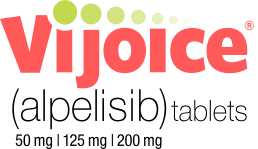
Study Design
VIJOICE was studied in adult and pediatric patients with PIK3CA-Related Overgrowth Spectrum (PROS).
The clinical evidence of VIJOICE is from a median of 3.5 years and up to 6 years of treatment with the pooled EPIK-P1 and EPIK-P3 studies1,2
EPIK-P1 (N=57)
A single-arm, retrospective, medical chart review study that followed pediatric and adult patients with PROS who received at least 1 dose of VIJOICE at least 24 weeks before the data cut-off date as part of a compassionate use program.1,3
Study information (NCT04285723)
The study included 57 patients (39 pediatric patients and 18 adult patients) 2 years of age and older with severe or life-threatening PROS necessitating systemic treatment who received VIJOICE as part of a compassionate use program1,3
A total of 58 patients were eligible for inclusion, but 1 patient withdrew consent; therefore, 57 patients were included in the full study population3
Inclusion criteria
Patients had to have documented evidence of a mutation in the PIK3CA gene3
Patients had heterogeneous manifestations of PROS, including CLOVES syndrome (81%), MCAP (or M-CM) (8%), KTS (2.7%), FIL (8%), and other (5%). Five percent of patients had concurrent manifestations of CLOVES syndrome and MCAP (or M-CM)1
The efficacy population (N=37) for EPIK-P1 was a subset of the full study population and included patients who had at least 1 target lesion identified on imaging performed within 24 weeks prior to receipt of the first dose of VIJOICE3
PRIMARY END POINT1
Response at Week 24
Response, as determined by BICR, was defined as the proportion of patients achieving a ≥20% reduction from baseline in the sum of measurable target lesion volume (1 to 3 lesions) confirmed by at least 1 subsequent imaging assessment, provided that:
None of the individual target lesions had a ≥20% increase from baseline,
Nontarget lesions had not progressed, and
There were no new lesions, as determined by BICR
SELECT SECONDARY END POINTS3
Duration of response, defined as the time from the first documented response to the date of the first documented disease progression or death due to any cause
Changes in the sum of measurable target lesion volume (1 to 3 lesions) over time, as determined by ICRR
Changes in PROS signs, symptoms, and complications over time
Changes in performance status over time
Assessment of PROS-related surgeries over time
Assessment of safety and tolerability
EPIK-P3 (N=48)
An ongoing clinical study with retrospective and prospective phases that enrolled a subset of patients from EPIK-P1. At completion of the retrospective chart review phase of EPIK-P3, patients had received VIJOICE for at least 2 years and up to 6 years after starting EPIK-P1.2
Study information (NCT04980833)
The study included 34 pediatric patients and 14 adult patients2
At the end of the retrospective phase, patients were assessed for clinical changes from when they started VIJOICE in EPIK-P12
Responses to VIJOICE were classified as improved, stable, or worsened based on assessment of each patient’s condition by the treating HCP4
Forty patients were enrolled in the ongoing prospective period of this study2
PRIMARY END POINT (PROSPECTIVE PERIOD ONLY)4
Incidence of new or worsening grade ≥3 treatment-emergent AEs
SECONDARY END POINTS (RETROSPECTIVE AND PROSPECTIVE PERIODS)4
Proportion of patients with AEs
Overall clinical assessment by investigator
Incidence of PROS-related symptoms and complications/comorbidities
Hospital utilization
Proportion of patients requiring PROS-related therapies other than alpelisib
Proportion of patients with PROS-related surgeries
EPIK-P1 + EPIK-P3
Data from EPIK-P1 and EPIK-P3 were pooled (EPIK-P1 + EPIK-P3) and described for each patient from treatment start date in EPIK-P1 to the end of the EPIK-P3 retrospective period. Only EPIK-P1 data are included for patients who discontinued during EPIK-P1 or did not participate in EPIK-P3.2
Median duration of treatment with VIJOICE in the full population (N=57) was 42.0 months (range: 3.4-74.8 months)2
- 22.8% of patients were treated more than 60 months
- Despite the extended duration of treatment (median 43.3 months [range: 3.4-64.4]), pediatric patients continued to experience normal growth trajectory during treatment with VIJOICE
43.9% of patients (N=57) had been treated with sirolimus between diagnosis and initial treatment with VIJOICE3
- The median duration of treatment with sirolimus was 8 months (range: 1-87 months)
87.7% of patients (N=57) had at least 1 surgery between diagnosis and initial treatment with VIJOICE3
- 92.2% (260/282) of surgeries were due to disease progression
